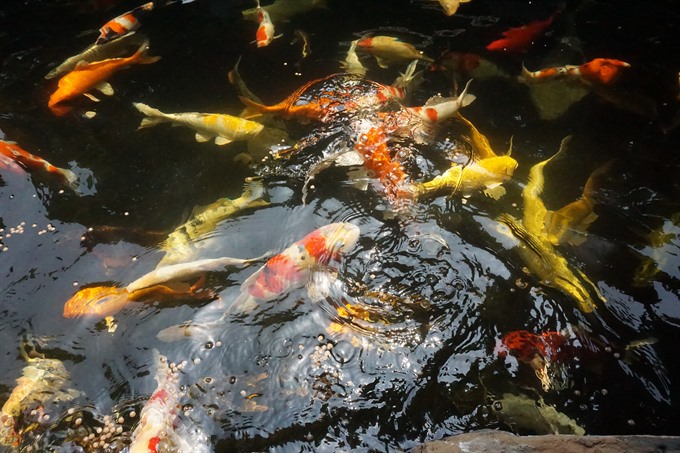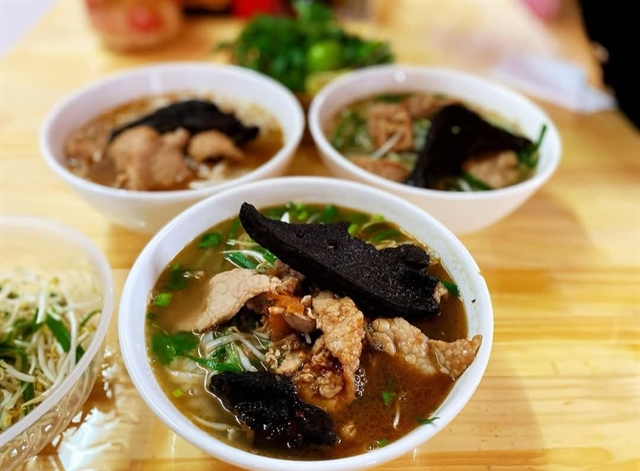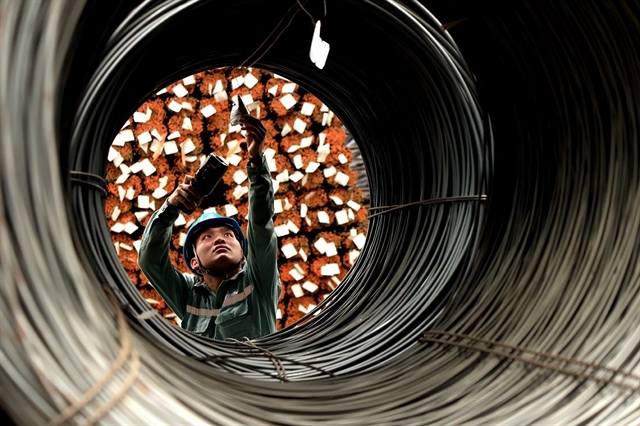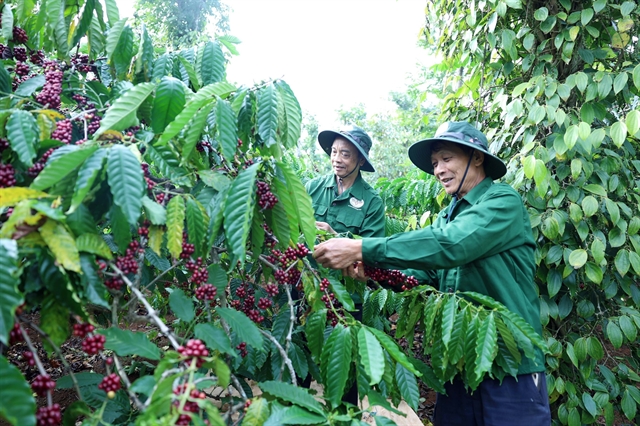

The amazing tunnels at Củ Chi are attracting many visitors.
 |
| They’re biting: Koi varieties such as Kohaku, Ogon, Showa, Sanka, Kohaku and Chagoi are bred at the Koi Garden, a special combination of aquaculture and ecotourism in Củ Chi District. Photo Thu Hằng |
The amazing tunnels at Củ Chi are attracting many visitors.
They are considered the world’s top underground tourist attraction.
The success of the tunnels as a tourist destination has led to other developments in the area.
Farms have started up where visitors can enjoy country activities when they take a break from the city.
By Sơn Hà
Arguably, no visitor to HCM City, or Việt Nam, even, will miss a trip to the Guerrilla Warfare Tunnels.
They are a dark reminder of dark days, and a fantastic reminder of incredible bravery, ingenuity and indomitable spirit.
The underground network of tunnels that will never cease to amaze, with its sheer length and facilities like trenches, docks, dining spaces, bedrooms and warehouses, has come out of hiding to become a living museum of the Resistance.
The earliest tunnel appeared in 1948 in two communes of Tân Phú Trung and Phước Vĩnh An. At first, there were just short and simple complexes for hiding documents, weapons and some guerrillas.
Later, more tunnels were dug and wound their way to neighbouring communes. Between 1961 and 1965, six communes in the north of Củ Chi had completed the “backbone” tunnel. Branch tunnels connected with the backbone to form a network that could be expanded, if needed. They were needed. The Củ Chi Tunnels expanded rapidly, especially in the beginning of 1966, as the fight against American intensified.
By 1967, the tunnel system had a total length of 250 kilometres, a man-made wonder.
The “iron land” of guerrilla forces has now transformed itself, from an area most devastated by war in the southern region into a popular tourist destination and now, a “new rural area”.
The world’s top underground tourist attraction welcomed around 1.5 million visitors last year, 650,000 of them foreigners, says Colonel Trần Văn Tâm, director of Historic Relics & Củ Chi Tunnel Complex.
There is a proposal to expand the Củ Chi Tunnel Complex by 125 hectares, and authorities are looking for investors for it, he says.
They hope to create products and services that educate the younger generations about the country’s revolutionary traditions while also entertaining visitors, he says.
War’s over
Today, Củ Chi has much more to offer than the vestiges of war.
Thanks to a dense waterway system and a picturesque rural and river landscape along the Sài Gòn River and Xáng Canal, several ecotourism sites have sprung up in the district over the last decade.
Given its proximity and ease of access to downtown HCM City, these sites have made Củ Chi an ideal, hassle-free weekend escape from the hustle and bustle of city life.
Established in 2010, the Green Noen farm, a pioneer in the area in terms of combining farming with ecotourism, has helped thousands of students learn about agriculture and rural life.
The 20-hectare farm in An Nhơn Tây Commune grows mushrooms, orchids and organic vegetables, and breeds cows, deer, goats, sheep, horses, chicken and ducks.
It has 33 mushroom “houses”, four animal breeding facilities that take care of hundreds of animals, and a 5,000sq.m garden of organic watermelons and various kinds of vegetables.
Moreover there is a freshmilk processing line with the capacity of two tonnes per hour.
All the feed for animals and other farm inputs are produced either on the farm itself or bought from neighbouring farms, boosting the local economy.
Visitors to this farm can enjoy the rural setting, breathe in fresh air and acquire hands-on experience in rice cultivation, mushroom collection, milking cows, nurturing animals, picking eggs and packaging milk, says Nguyễn Thị Thu Hương, director of the farm.
They can also enjoy dishes cooked with fresh organic farm produce. Overnight stay and camping facilities are also available at the Green Noen.
The farm welcomes thousands of students and tourists every year, Hương says.
Fish and fishing
On a 10-hectare plot on the banks of the Sài Gòn River in Trung An Commune’s Hòa An Hamlet, the Hải Thanh Koi Farm comfortably brings aquaculture and ecotourism together.
The garden uses modern technology to produce high-quality koi fish for local breeding and export.
Opened in November last year, the garden invests VNĐ150 billion (US$6.63 million) in a koi breeding area, orchids garden, fishing area, a restaurant and a wharf to receive tourist boats.
Many Koi varieties like kohaku, ogon, showa, sanka, and chagoi are bred at the garden.
Tourists can reach the garden by bus or speedboats from HCM City.
Other ecotourism ventures like Bình Mỹ and Fosaco villages are also ideal destinations for a break from the daily rush to enjoy the peace and quietness of a suburban rural area.
Big plans
The district is looking to cash in on the ecotourism with the US$500 million Saigon Safari project that will stretch over 457 hectares, including an open zoo, breeding and animal care facilities as well as recreational zones, entertainment facilities, hotels and restaurants.
The safari will be home to 10,000 animals of 300 species and 3,000 species of plants.
The city’s authorities have urged the district to implement the long-planned project which has been delayed for many years due to site clearance and compensation issues.
Last year, the city’s People’s Committee approved a proposal by the Vinpearl Joint Stock Company to develop the safari park.
The park can handle 3,000 visitors coming on day tours and 1,800 staying on overnight.
Weak link
While ecotourism, river tourism and rural tourism have huge potentials to develop in Củ Chi, these have not been properly exploited because of underdeveloped transportation infrastructure and lack of quality services for tourists, says Trần Vĩnh Tuyến, deputy chairman of the city’s People’s Committee.
“To facilitate tourism development in Củ Chi, transportation infrastructure from the downtown HCM City to Củ Chi should be upgraded to cut travelling time to the tunnels and other tourist attractions,” Tuyến says.
The city plans to build an express highway and an overhead road to Củ Chi so that it takes only half an hour to get here from downtown, he says.
“River transportation facilities will also be developed to facilitate waterway travel from downtown to Củ Chi.
“Incentive policies in terms of tax reductions and exemptions for investors in tourism products and services in the district will also be put in place soon,” he adds.
“The city’s Department of Tourism will work with travel agents to develop various products and services that link the Củ Chi Tunnels with eco-tourism sites and traditional craft villages in surrounding areas,” says Bùi Tá Hoàng Vũ, director of the department.
Võ Anh Tài, deputy general director of Saigontourist, says Củ Chi must improve the quality and uniqueness of experiences that customers get through diverse products and services.
The number of tourists visiting Củ Chi reached nearly 2 million in 2016, an increase of 12 per cent compared to the previous year. The district’s tourism revenue for the year has been estimated at VNĐ156 billion (US$6.9 million).
Now available are half-day tours to the Củ Chi Tunnels by bus or speedboat, and full-day tours to the tunnels, Củ Chi wildlife rescue station, a craft village and/or an ecotourism site. —VNS
GLOSSARY
They are a dark reminder of dark days, and a fantastic reminder of incredible bravery, ingenuity and indomitable spirit.
Ingenuity means cleverness.
Indomitable means unbeatable.
The underground network of tunnels that will never cease to amaze, with its sheer length and facilities like trenches, docks, dining spaces, bedrooms and warehouses, has come out of hiding to become a living museum of the Resistance.
To cease means to stop.
At first, there were just short and simple complexes for hiding documents, weapons and some guerrillas.
Guerrillas are soldiers from small armies who fight against big, organised armies.
Later, more tunnels were dug and wound their way to neighbouring communes.
Wound, in this case, is the past tense of wind, which means to travel in many directions to get somewhere.
The “iron land” of guerrilla forces has now transformed itself, from an area most devastated by war in the southern region into a popular tourist destination and now, a “new rural area”.
To transform means to change from one thing into something different.
Devastated means ruined.
There is a proposal to expand the Củ Chi Tunnel Complex by 125 hectares, and authorities are looking for investors for it, he says.
A proposal is an idea someone puts forward.
Investors are people who spend money on something in the hope of making more money from it.
Today, Củ Chi has much more to offer than the vestiges of war.
A vestige is a sign.
Thanks to a dense waterway system and a picturesque rural and river landscape along the Sài Gòn River and Xáng Canal, several ecotourism sites have sprung up in the district over the last decade.
A decade is a period of ten years.
Given its proximity and ease of access to downtown HCM City, these sites have made Củ Chi an ideal, hassle-free weekend escape from the hustle and bustle of city life.
Proximity means distance from something.
Established in 2010, the Green Noen farm, a pioneer in the area in terms of combining farming with ecotourism, has helped thousands of students learn about agriculture and rural life.
A pioneer is someone who is among the first people to do something that is new.
The 20-hectare farm in An Nhơn Tây Commune grows mushrooms, orchids and organic vegetables, and breeds cows, deer, goats, sheep, horses, chicken and ducks.
Organic vegetables are vegetables that are grown with natural fertilisers rather than with chemicals.
All the feed for animals and other farm inputs are produced either on the farm itself or bought from neighbouring farms, boosting the local economy.
Boosting means giving more strength.
Visitors to this farm can enjoy the rural setting, breathe in fresh air and acquire hands-on experience in rice cultivation, mushroom collection, milking cows, nurturing animals, picking eggs and packaging milk, says Nguyễn Thị Thu Hương, director of the farm.
Acquire means get.
Nurturing means looking after something while it grows.
On a 10-hectare plot on the banks of the Sài Gòn River in Trung An Commune’s Hòa An Hamlet, the Hải Thanh Koi Farm comfortably brings aquaculture and ecotourism together.
Aquaculture means farming things in the water, such as fish.
The city’s authorities have urged the district to implement the long-planned project which has been delayed for many years due to site clearance and compensation issues.
To implement a project means to carry out a project.
Compensation means paying someone money to make up for having taken something away from them. In this case it would be land.
While ecotourism, river tourism and rural tourism have huge potentials to develop in Củ Chi, these have not been properly exploited because of underdeveloped transportation infrastructure and lack of quality services for tourists, says Trần Vĩnh Tuyến, deputy chairman of the city’s People’s Committee.
Potential means possibilities.
To exploit something means to get the most out of it.
“River transportation facilities will also be developed to facilitate waterway travel from downtown to Củ Chi.
To facilitate waterway travel means to make it possible.
“Incentive policies in terms of tax reductions and exemptions for investors in tourism products and services in the district will also be put in place soon,” he adds.
An incentive is a plan that encourages someone to do something.
A tax reduction is a plan that involves people being asked to pay less tax.
A tax exemption is a plan that involves people being asked to pay no tax.
Võ Anh Tài, deputy general director of Saigontourist, says Củ Chi must improve the quality and uniqueness of experiences that customers get through diverse products and services.
If there is uniqueness in an experience, then there is no other experience like it.
WORKSHEET
Find words that mean the following in the Word Search:
c | s | o | n | b | i | m | d | s | u | i | c |
j | g | i | p | w | i | q | z | a | n | x | p |
b | a | l | l | o | o | n | r | y | b | t | a |
n | l | n | k | o | s | i | l | h | e | r | t |
a | i | r | c | y | c | l | i | e | t | s | a |
c | b | b | i | e | a | s | i | c | i | i | e |
y | o | r | r | b | l | m | o | t | n | n | a |
i | n | i | t | a | x | l | b | a | d | i | e |
a | f | o | h | a | n | a | e | r | i | n | t |
u | d | u | s | p | e | c | i | e | s | g | s |
f | p | i | m | m | i | g | h | a | n | t | s |
© Duncan Guy/Learn the News/ Viet Nam News 2017
1. Branch; 2. Tax; 3. Species; 4. Hectare; 5. Koi.




